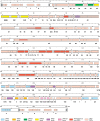Comparative genomics of carp herpesviruses
- PMID: 23269803
- PMCID: PMC3571366
- DOI: 10.1128/JVI.03206-12
Comparative genomics of carp herpesviruses
Abstract
Three alloherpesviruses are known to cause disease in cyprinid fish: cyprinid herpesviruses 1 and 3 (CyHV1 and CyHV3) in common carp and koi and cyprinid herpesvirus 2 (CyHV2) in goldfish. We have determined the genome sequences of CyHV1 and CyHV2 and compared them with the published CyHV3 sequence. The CyHV1 and CyHV2 genomes are 291,144 and 290,304 bp, respectively, in size, and thus the CyHV3 genome, at 295,146 bp, remains the largest recorded among the herpesviruses. Each of the three genomes consists of a unique region flanked at each terminus by a sizeable direct repeat. The CyHV1, CyHV2, and CyHV3 genomes are predicted to contain 137, 150, and 155 unique, functional protein-coding genes, respectively, of which six, four, and eight, respectively, are duplicated in the terminal repeat. The three viruses share 120 orthologous genes in a largely colinear arrangement, of which up to 55 are also conserved in the other member of the genus Cyprinivirus, anguillid herpesvirus 1. Twelve genes are conserved convincingly in all sequenced alloherpesviruses, and two others are conserved marginally. The reference CyHV3 strain has been reported to contain five fragmented genes that are presumably nonfunctional. The CyHV2 strain has two fragmented genes, and the CyHV1 strain has none. CyHV1, CyHV2, and CyHV3 have five, six, and five families of paralogous genes, respectively. One family unique to CyHV1 is related to cellular JUNB, which encodes a transcription factor involved in oncogenesis. To our knowledge, this is the first time that JUNB-related sequences have been reported in a herpesvirus.
Figures






References
-
- Pellett PE, Davison AJ, Eberle R, Ehlers B, Hayward GS, Lacoste V, Minson AC, Nicholas J, Roizman B, Studdert MJ, Wang F. 2011. Herpesvirales, p 99–107 In King AMQ, Adams MJ, Carstens EB, Lefkowitz EJ. (ed), Virus taxonomy, 9th report of the International Committee on Taxonomy of Viruses. Elsevier Academic Press, London, United Kingdom
-
- Gessner C. 1558. Historiae Animalium, vol IV C. Froschauer, Zurich, Switzerland
-
- Hofer B. Handbuch der Fischkrankheiten. Verlag der Allgemeinen Fischerei-Zeitung, B; Heller, Munich, Germany: 1904.
-
- Wolf K. 1988. Fish viruses and fish viral diseases, p 253–263 Cornell University Press, Ithaca, NY
-
- Lowenthal W. 1907. Einschlussartige Zell- und Kernveränderungen in der Karpfenpocke. Z. Krebsforsch. 5:197–204
Publication types
MeSH terms
Substances
Associated data
- Actions
- Actions
Grants and funding
LinkOut - more resources
Full Text Sources
Other Literature Sources
Research Materials

